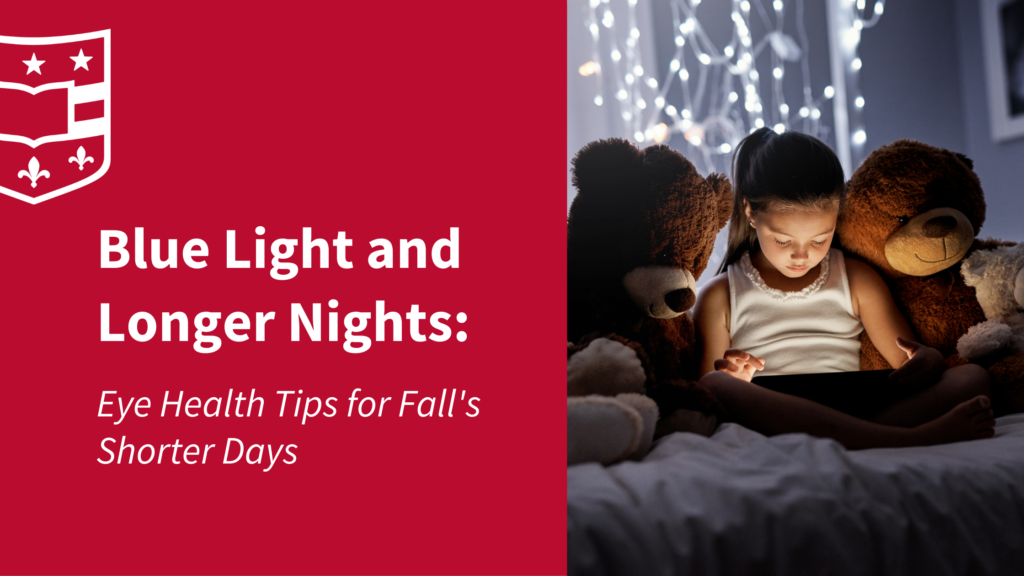As the days grow shorter and nights lengthen during the fall, many of us spend more time indoors, often in front of screens. Increased screen time exposes our eyes to more blue light, which can lead to digital eye strain and discomfort. Here’s how you can protect your eye health this fall, while separating fact from fiction about blue light.
1. Limit Screen Time
While avoiding screens entirely may be unrealistic, try to limit your screen time whenever possible. Take regular breaks by practicing the 20-20-20 rule: every 20 minutes, look at something 20 feet away for at least 20 seconds. This simple habit helps reduce eye strain and gives your eyes a break.
2. Skip the Blue Light-Blocking Glasses
Eyeglasses that claim to filter blue light from devices like computers, smartphones, and tablets have gained popularity. These ads suggest blue light can cause digital eye strain, disrupt sleep cycles, and even lead to eye diseases. However, there is no scientific evidence that blue light from screens damages the eyes. The American Academy of Ophthalmology does not recommend blue light-blocking glasses for computer use.
The discomfort people feel after long periods of screen use is most likely caused by how they use their screens, rather than the blue light itself. Less blinking while staring at screens can cause temporary eye strain and dryness, but it doesn’t lead to permanent damage. Taking frequent breaks and practicing good screen habits is more effective than relying on special glasses.
3. Use Night Mode to Protect Sleep, Not Your Eyes
Blue light plays a role in regulating our body’s circadian rhythm, which controls our sleep-wake cycle. Too much exposure to blue light in the evening can disrupt your ability to fall asleep. The best way to avoid this is to limit screen use two to three hours before bed. You can also use the “night” or “dark” mode on your devices to reduce blue light exposure in the evenings.
4. Adjust Your Lighting
Proper lighting is essential when using digital devices. Ensure the lighting in your room is not too bright or too dim, as either can contribute to eye strain. Try to position your screen to avoid reflections from windows or overhead lights. Soft, warm lighting in your environment can also create a more comfortable atmosphere for your eyes.
5. Maintain Proper Distance
When using a computer or mobile device, keep a comfortable distance from the screen. Your screen should be about 20 to 24 inches from your eyes, with the top of the screen at or just below eye level. This helps reduce eye strain and encourages better posture.
6. Blink More Often
Staring at screens can cause you to blink less, leading to dry eyes. Make a conscious effort to blink more frequently when using digital devices. If your eyes feel dry, consider using lubricating eye drops to relieve discomfort.
7. Remember: The Sun Emits More Blue Light
The largest source of blue light isn’t your phone or computer—it’s the sun. While blue light from screens is far less intense than sunlight, it’s still important to protect your eyes from excessive exposure to natural UV light. Overexposure to sunlight can increase the risk of cataracts and other eye diseases, so always wear UV-blocking sunglasses outdoors.
Final Thoughts
Fall’s shorter days might lead to more time spent in front of screens, but the key to protecting your eyes is how you use those screens. By limiting screen time, practicing the 20-20-20 rule, adjusting your lighting, and avoiding late-night screen use, you can reduce digital eye strain without needing blue light-blocking glasses. And remember, the best way to protect your eyes from strain is to give them frequent breaks.
For any persistent symptoms or concerns, consult your ophthalmologist or optometrist.
